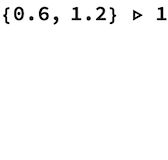This question could sound pretty silly but I can't find a way to apply element -wise tests to a list.
For example if I digit
{0.6, 1.2}>1
{{0.6,1.2},{5,0.1}}>1
I would expect to obtain
{False,True}
{{False,True},{True, False}}
respectively, but it is not the case.
Of course I can define a function or using Map, but I can't believe there is not a core function providing this kind of result.
Thank you for any indication



Mapat level{-1}covers both cases. $\endgroup$